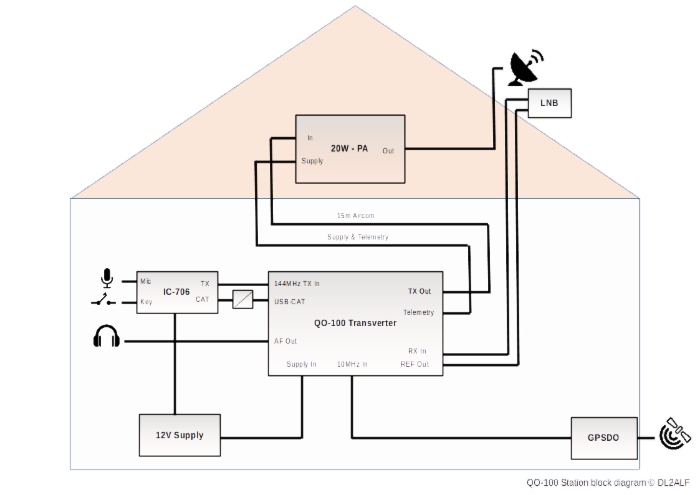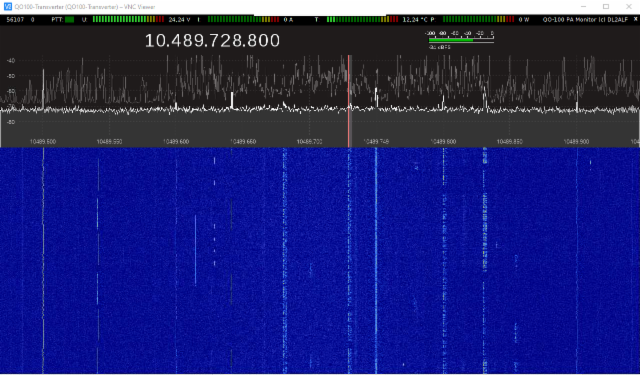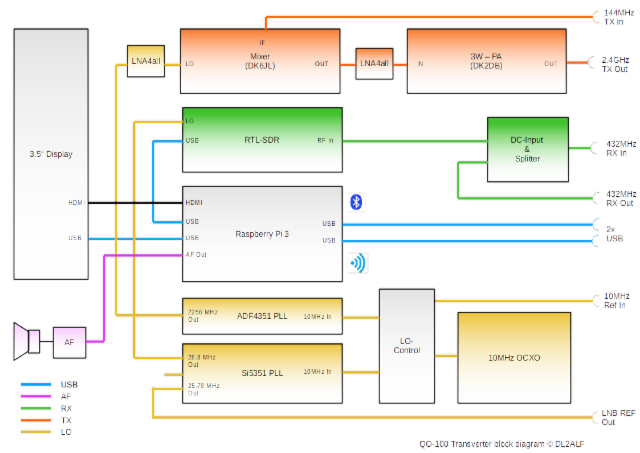QO-100
I've been fascinated by satellites from the very beginning of my amateur radio live. So I started as soon as I got my own station equipment with working over AO-7 and AO-13 (as long as it was operational). In the last years I was less QRV due to other amateur radio activities.
This had changed with the launch of QO-100. I quickly soldered some modules together for an experimental TX setup while RXing was done via web SDR @ Goonhilly.
Now, about one year later, I finished my transverter project to become QRV on a regular basis. I decided to realize a conventional (but very flexible) concept, which can be used as a standalone transverter inside and outside the shack, with or without a computer.

Well, it doesn't look so pretty inside. This is because the device was developed "in-situ". Changing concepts and modules during the development process resulted in a lot of orphaned drillings in the mounting plate and in a sub-optimal arrangement of particular modules. But it works, anyway.
Concept
The idea was:
- not to use a complete SDR solution for the transverter (like AdalmPluto or similar)
- rather use a convetional setup which can be operated with classical transceivers
- not to use a commercial solution
- rather use own ideas with cheap Chinese boards and learn how they work and how to use them
This was requiring:
- a conventional mixer for TX uplink
- a modified LNB for downlink and output the IF inside a amateur radio band
- PLLs to generate all frequencies needed
- microprocessor or a computer to control the PLLs (Raspberry Pi seems to be ideal)
And these requirements resulted in a lot of additional functionality:
- fully integrated RX solution with a RTL-SDR stick and gqrx
- spectrum display on the front panel
- headphone jack and loudspeaker
- remote operation of RX via Bluetooth or WIFI
A clear statement first
This transverter is my personal trade-off between best possible technical parameters and best possible flexibility. It is more or less an experimental platform for different setups.
If you are looking for "the ultimate concept" with outstanding technical data you can stop reading here.
Configuration Examples
1. Operation @portable with one single 144 or 432MHz transceiver

Designed to work outside with a minimum of external components. Running with a single 144 or 432MHz transceiver for uplink. The internal RTL-SDR is used for receiving the downlink. All frequencies are controlled by the internal OCXO. A tablet or smartphone (connected via WIFI) can be used to remote the sdr console.
2. Operation @home, simple configuration with one single 144 or 432MHz transceiver


Block Diagram
Main Modules / Components / Ideas used
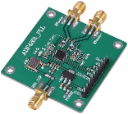 TX-PLL with ADF4351
TX-PLL with ADF4351 TX mixer
TX mixer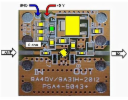 LNA4All as small signal amplifier
LNA4All as small signal amplifier Multi-PLL with Si5351 for LNB, RTL-SDR
Multi-PLL with Si5351 for LNB, RTL-SDRIt turned out that using a Si5351 as LNB reference is not the best possible solution. The jitter & spurious of the output signal (multiplied by 390 in the LNB's PLL) are limiting the receiving capabilities. With some fine tuning on the IC's registers I was able to keep the spurious -30dB on the whole satellite RX passband. With my setup (60cm offset dish) the beacon is abt. 25dB above the noise level, means: all spurious are vanishing. There are still problems with the Leila alarm signal when active. Things may become different on a bigger dish...
 Raspberry Pi 3 as contoller and RX with Linux & gqrx
Raspberry Pi 3 as contoller and RX with Linux & gqrx 3,5" display as a spectrum display
3,5" display as a spectrum display Dual splitter
Dual splitter PAM8610 10W AF amplifier
PAM8610 10W AF amplifier Diavolo Dual LNB
Diavolo Dual LNB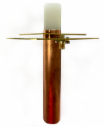 POTY patch feed for 2.4GHz TX
POTY patch feed for 2.4GHz TX Automatic reference input switching
Automatic reference input switching SG-Labs 20W - PA with telemetry
SG-Labs 20W - PA with telemetry
My latest project finished in December 2020. As the distance from my shack to the roof is more than 15m I need to amplify the 13cm uplink near the antenna. A SG-Labs PA in a separate housing is placed right underneath the roof to provide the necessary RF power. The homemade telemetry pcb with an ATMEGA 8 perfectly fits on the top of the PA. It is getting voltage, current, temperature and output power and is sending it via RS-485 to the transverter in a simple ASCII format.
Software Components
Other software running on the Raspberry PI:
